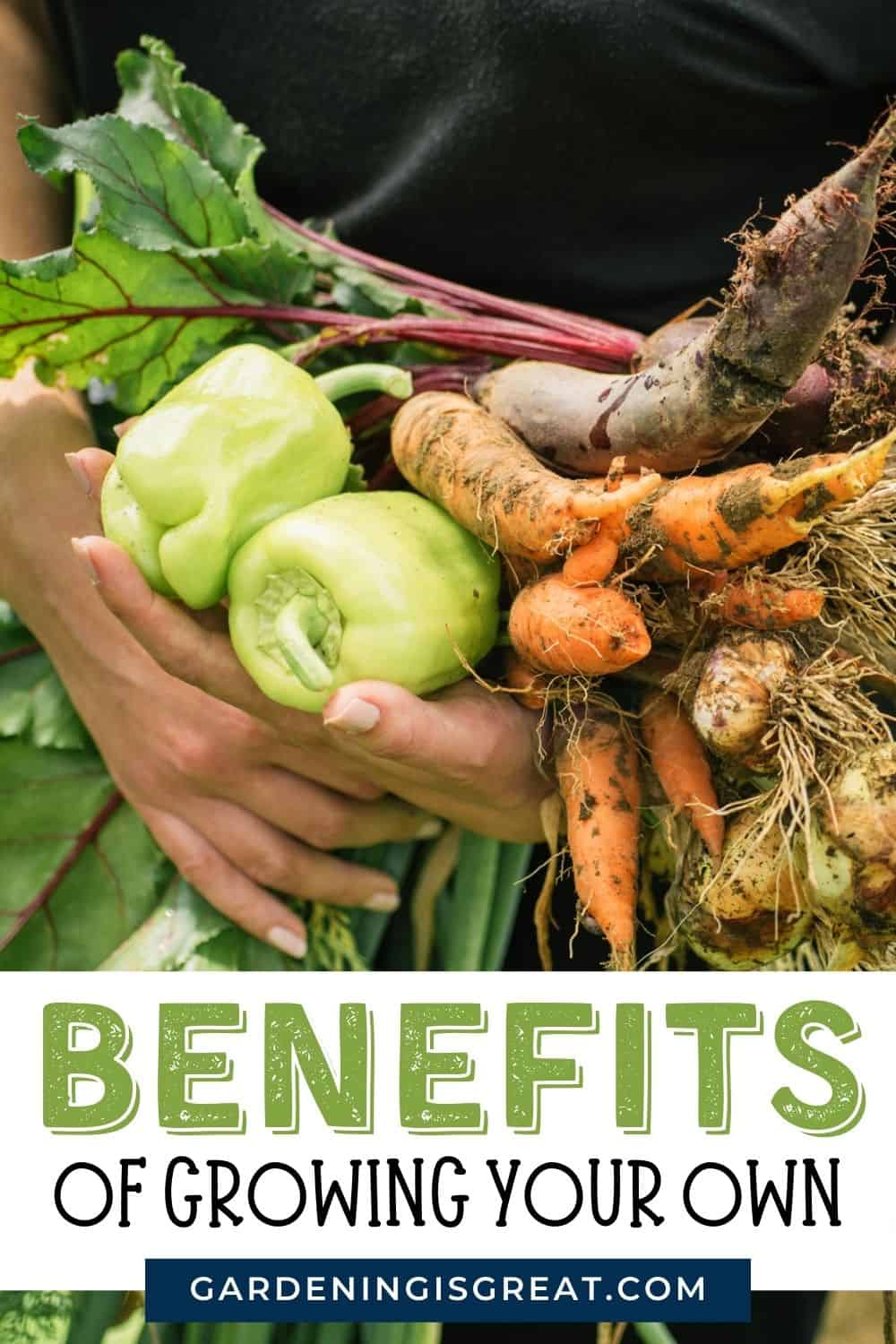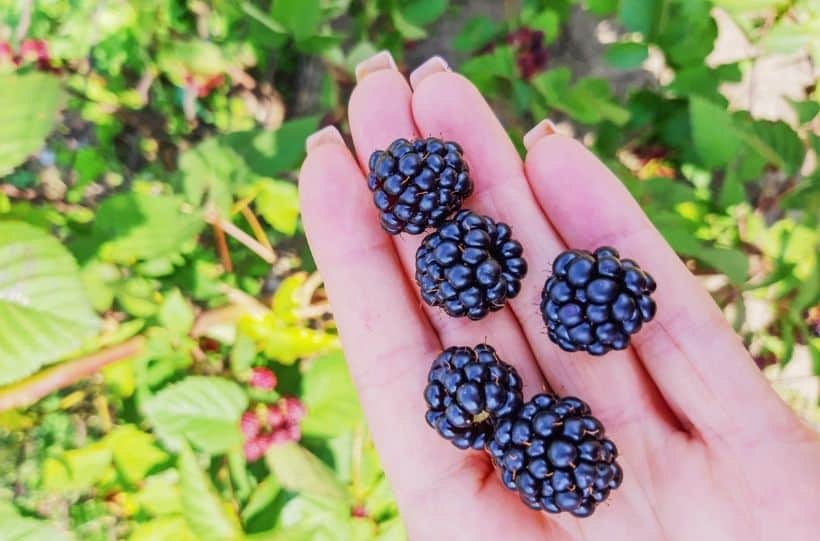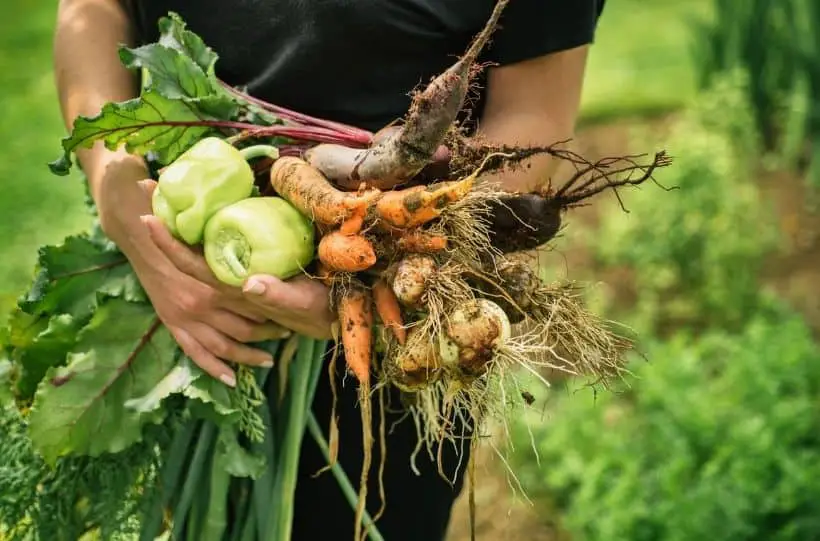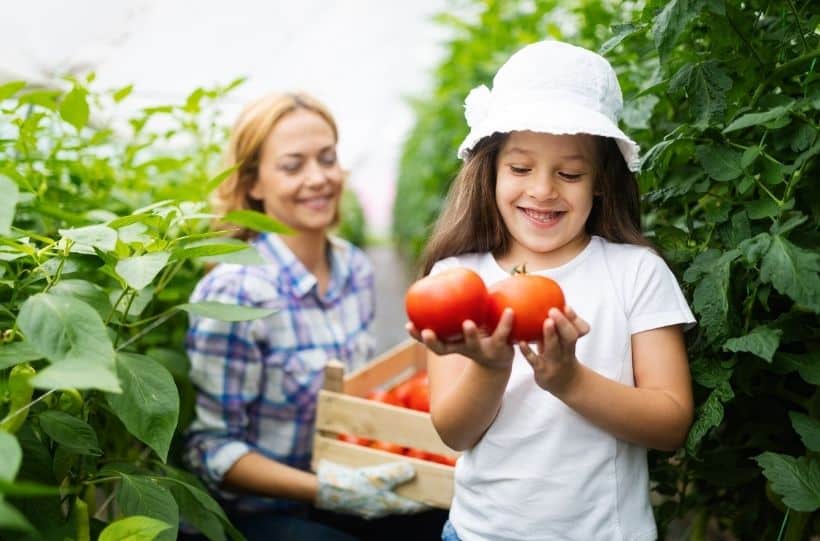12 Benefits Of Growing Your Own Food
Gardeners more often than not are choosing to grow their own food from home. Food price increases, the worry of harmful pesticides, and the increasing amount of food waste have all led to a substantial increase in home-grown food.
But do the benefits outweigh the time and effort needed to successfully produce a good harvest every single year?
Yes, they do! All gardeners, no matter their level of experience and expertise, are finding that the pros significantly outweigh the cons when growing your own food. This is even more significant the longer you have been growing food.

The benefits of growing your own food include eating fresh produce, supporting your local wildlife, and being able to save money.
If you are considering growing your own food from home, but aren’t sure of the benefits, keep on reading to see just how much of a positive impact it could have on the environment, your health, and your pocket.
12 Benefits Of Growing Your Own Food
Save Money
With everything costing more, it only makes sense that there is an increase in gardeners turning to growing their own food to save money.
Not only do you save money on expensive produce at the supermarket. You also save money on gas, parking, and packaging.
According to How Stuff Works, with an outdoor area of 4×8 feet to grow your own fruit and vegetables, the average gardener can save $600 over the summer months alone.
Yes, there are the upfront costs of starting with seed packets, gardening tools, and quality compost. However, when you purchase fresh produce in the supermarket, you are only purchasing single-use items.
Compared with those grown at home that can produce several items per harvest and, if a perennial plant, will continue to produce in the following years.
The longer you commit to growing your own food, the more money you will save compared with any upfront costs.
Fresh Supply
Have you ever picked fresh blackberries on a walk and popped them straight into your mouth? How fresh did they taste?

On average, the produce you purchase from stores has traveled anywhere up to 2500 miles before it reaches you.
During that transit, produce is gradually decreasing in vitamins and minerals. As soon as produce is picked, it begins to lose its nutritional value.
That blackberry you pick and eat straight from the blackberry bush on your walk, will not only taste better but will be full of nutrients. Compare this with the blackberry that’s traveled 1000s of miles to your local store and has had to be preserved with chemicals to prevent decay. Which one would you prefer?
Limit Food Waste
Did you know, the UK alone throws away 9.52 million tonnes of food every year?! A whole third of produce, 1.3 billion tonnes, goes to waste every year.
As the fresh food that arrives at the supermarket has usually already had a long journey since being picked, it doesn’t have a much longer life span before it is classed as inedible. This food is thrown away in large quantities if it isn’t sold.
Whereas by growing your food at home, you cut out the middle man, and the long time fresh food is spent in transit.
This enables you to enjoy eating fresh, higher-quality produce. But also enables you to only harvest what you need at the time, or freeze the rest to enjoy another day.
Grow Crops You Eat
Following on from the above point, another way to help limit food wastage and save money is to only grow the number of crops your household needs.
Large stores usually have a surplus amount of food to ensure they meet the demands and needs of all consumers. However, because they have large numbers, this leads to increased food waste as use by dates begin to expire.

When growing your own food, you only need to grow the amount that your household requires. You can also select seasonal fruits and vegetables to help improve your harvest with crops that succeed in different seasons.
Additional Compost
Even though you are growing your own food at home, there will still inevitably be some amount of food waste.
However, that isn’t to say that food waste has to go to landfills!
Food waste, expired crops, or the annual crops left over after the growing season, can often be added to your compost. With the right conditions, this will help to generate a healthy, organic supply of compost for the following year.
Not only are you ensuring to use all parts of the crop, but you’ll also save money on pre-packed compost from garden centers.
No Chemicals
Unfortunately, in farming all around the world, unnatural chemicals, fertilizers, and pesticides are being used whilst growing the food that we consume.
Though some testing has taken place on these chemicals, there is no indication as to their safety when combined or when eaten.
Unfortunately, a vast amount of chemicals are used in the production and post-production of our fresh fruit and vegetables. Revisiting an earlier fact in the post, farmers need to be able to preserve their freshly picked crops so that it lasts the long journey to the supermarkets. To do so, they often spray chemicals that create a wax coating on the food you eat.
Other chemicals are often used to discourage pests, delay ripening, kill fungi, and even improve the produces’ color.
These chemicals can pose health risks and are difficult to identify just how many chemicals are in each item you consume.
However, when growing your food, you can successfully grow healthy fresh produce without the need for chemicals.
Natural organic matter, natural fertilizers, and natural pesticides are all available to ensure the food you grow is not compromising your health.
Lower Carbon Emissions
Carbon emissions are a global problem that is becoming a topic of conversation the average person is having at home. Carbon emissions are an ongoing problem that contributes to global warming.
So how does this have anything to do with the food you buy or grow?
Well, carbon emissions are released through:
- the chemicals that are used on certain farms,
- packaging to store produce,
- and of course, the fumes released during transit from the farm to the store.
By growing your own food at home, not only can you ensure to use organic material e.g. compost to reduce carbon emissions. You are also removing the need for packaging and reducing carbon emissions as your food isn’t being transported from 1000s of miles away.
Less Plastic Use
Another huge concern around the world is the amount of plastic being used having such a profoundly negative impact on our environment.
The majority of all plastics used in the world are not fully biodegradable. This means that yes, over a long time, they do break down, but not fully. Most plastics will break down into smaller pieces, known as microplastics.
These microplastics end up largely in our oceans impacting wildlife and ocean habitats. According to Our World in Data, 80% of the world’s plastics found in the ocean comes from land and are only set to increase without a global combined effort.
As a gardener, one of the benefits of growing your own food is the lack of plastics needed to do so successfully. Compared with purchasing store produce where almost everything is contained in plastic packaging, there is no need when you use your fresh, home-grown produce.
Each crop can either be harvested as and when needed in the kitchen. Alternatively, excess produce can be gifted to local food charities or frozen for use at a later date. This seemingly small change can have an incredibly positive impact on the environment and wildlife.
Attract Beneficial Wildlife
A huge benefit to growing your own food at home is the increase in wildlife you’ll see in your garden.
Planting a range of crops can help provide shelter and food for local wildlife including bees, butterflies, and birds.
If you’d like to offer even more support to your local wildlife, whilst also protecting your crops, a bonus is to plant companion plants that help:
- Deter pests away from your crops
- Provide food for local pollinators
- Add nutrients to the soil that your crops can benefit from.
First, ensure to research what wildlife is local to the area you live in and then add plants to your garden that complement one another but also benefit wildlife.
In return, wildlife will help to pollinate your crops and aid a successful harvest.
Exercise
Managing and maintaining a garden of any size requires physical effort. As any gardener will tell you, gardening is an excellent form of exercise.
Setting yourself a challenge of growing your own food encourages you to spend more time outside, not only benefiting your lungs and skin with fresh air but also keeping you physically healthy and strong.
Gardening requires lots of manual labor including digging, bending, lifting, and stretching. With frequent activity, gardening can help keep you fit and strengthen your muscles.
However, do ensure to consult your doctor if you are making a dramatic change to your lifestyle before physically dedicating yourself to your garden. Also, remember to only carry as much as you possibly can and use gardening tools such as a knee bench to support you.
Activity for Any Age
The good news is that even though gardening can be strenuous and physically hard work, you can adjust it depending upon your ability and age.
Growing your own crops can be an excellent activity for all ages. Involving kids can be especially beneficial as it not only helps them to see where their food comes from but they can directly get involved in the growing process.
For older gardeners, growing crops does not have to be at ground level and is particularly strenuous work. You can still enjoy growing your own crops just by adjusting your methods to suit your needs e.g.
- Planting herbs inside with easy access on the windowsill
- Adding raised garden beds so that you don’t have to bend down as much whilst gardening
- Using containers so weeding and maintenance are easier to manage.
Provide to Those in Need
The cost of living, especially food, is on the increase leaving more and more people struggling to survive on their income.
When you grow food at home for your own family, often you end up with a surplus of food. Often, this needs harvesting within a certain amount of time otherwise it will begin to decay. However once harvested, most crops do not last very long without being frozen.
One way to minimize food waste at home is to donate your excess food to families in need or food banks. This way, you still get the enjoyment of growing your own food and all the benefits mentioned above, whilst also supporting your local community and those in need.

These 12 benefits of growing your own food highly outweigh the time, effort, and expenses needed to start. It does take time every week to maintain and look after your crops and yes there is an initial cost outlay required to start your fruit and vegetable garden.
However, this time and cost are minimal in comparison to the cost of purchasing pre-packed produce from your local store.
With so many guides, growing your food has never been easier. Take a look at some of our top guides for beginners here to help you get started:

